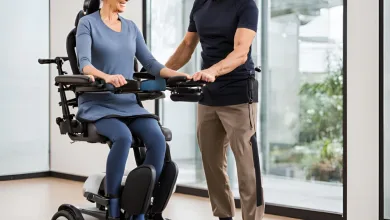Hemi Walker: Enhance Mobility & Independence

Table of Contents
Hemi Walker: The Ultimate Guide to Mobility and Independence
Navigating life with limited mobility can be challenging and often requires the aid of reliable mobility devices. One such device that stands out is the Hemi walker. This blog post will provide you with an in-depth guide on Hemi walkers, including their benefits, types, usage tips, and maintenance. By the end of this article, you’ll have a comprehensive understanding of Hemi walkers and how they can enhance the quality of life for those who need them.
What is a Hemi Walker?
Imagine a supportive arm that helps you walk with more confidence. That’s what a hemi walker does! It’s a mobility aid designed for people who have weakness or paralysis on one side of their body, often due to conditions like stroke or injury. Unlike a standard walker with four legs, a hemi walker has one open side, allowing you to use it comfortably with your stronger arm.
When to Use a Hemi Walker
A hemi walker can be a game-changer for individuals who:
- Have difficulty walking due to weakness on one side.
- Need extra support for balance and stability.
- Experience limited mobility in one arm.
- Are you recovering from a stroke or other neurological condition that affects one side of the body?
Features of Hemi Walkers
Hemi walkers are designed with specific features to cater to individuals with unilateral weakness or limited use of one side of their body. Here are some key features of hemi walkers:
- Single-Handed Use: Hemi walkers are designed to be operated with one hand, making them ideal for users who have limited use of one arm.
- Lightweight Frame: These walkers are typically made from lightweight materials, making them easy to lift and manoeuvre.
- Broad Base for Stability: The base of a hemi walker is wider than that of a standard cane, providing greater stability and reducing the risk of falls.
- Adjustable Height: Many hemi walkers come with adjustable height settings to accommodate users of different heights, ensuring a comfortable and supportive fit.
- Compact Design: Hemi walkers are more compact than traditional walkers, making them easier to use in tight spaces and more convenient to transport.
- Non-Slip Rubber Tips: The feet of hemi walkers are often equipped with non-slip rubber tips to provide better traction and prevent slipping on various surfaces.
- Foldable Options: Some hemi walkers are designed to be foldable, allowing for easy storage and portability.
- Ergonomic Handle: The handle of a hemi walker is designed to be comfortable to grip, reducing strain on the hand and wrist during use.
- Durable Construction: Hemi walkers are built to be sturdy and durable, capable of supporting the user’s weight and withstanding regular use.
- Optional Accessories: Some hemi walkers come with optional accessories such as trays, baskets, or seats, adding convenience for the user.
These features make hemi walkers a practical and effective mobility aid for individuals who need support on one side of their body.
Benefits of Using a Hemi Walker
Hemi walkers offer numerous benefits that can significantly improve users’ quality of life. Here are some key advantages:
1. Mobility: Hemi walkers enhance mobility by providing the necessary support for walking, allowing users to move around more freely and confidently.
2. Stability and Balance: The broad base and sturdy construction of Hemi walkers offer excellent stability and balance, reducing the risk of falls and accidents.
3. Independence: Using a Hemi walker can help maintain a sense of independence, enabling users to perform daily activities without constant assistance.
4. Convenience: Hemi walkers are designed for ease of use and portability. Their lightweight and compact design makes them easy to carry and store, adding to their convenience.
Types of Hemi Walkers
There are several types of Hemi walkers to cater to different needs and preferences. Understanding these variations can help you choose the right one for your specific requirements.
1. Standard Hemi Walkers
Standard Hemi walkers are the basic model, offering simplicity and functionality for everyday use. They are suitable for those who need a reliable and straightforward mobility aid.
2. Folding Hemi Walkers
Folding Hemi walkers are designed for easy storage and transport. They can be folded flat, making them ideal for travel or users with limited storage space.
3. Adjustable Hemi Walkers
Adjustable Hemi walkers come with features that allow customization to fit the user’s height and comfort needs, ensuring optimal support and usability.
4. Hemi One-Handed Walker
A Hemi walker and a Hemi one-handed walker are essentially the same mobility aids. Both are specifically designed for single-handed use, providing stability and support for individuals with limited use of one side of their body. These walkers are ideal for those recovering from conditions like a stroke or hemiplegia.
Various Aspects of Hemi Walkers
Now, let’s explore the various aspects of Hemi Walkers to enhance mobility and make life easier.
Hemi Rollator Walker
The Hemi rollator walker is a variant of the Hemi walker that includes wheels at the base. This design allows for a smoother and more effortless walking experience, making it particularly beneficial for individuals with reduced stamina or those who need to navigate longer distances.
Hemi Walker Cane
A “Hemi Walker Cane” isn’t an officially recognized mobility aid. Still, the term might be used to describe a hemi walker that has a smaller, more compact base, resembling a cane more than a traditional walker. This type of walker offers increased support compared to a standard cane, providing stability for those with moderate mobility issues. Essentially, it combines the features of a hemi walker and a cane, offering a balance of support and convenience for users who need more stability than a cane but less bulk than a full-sized walker.
Hemi Walker for Disabled
A hemi walker is an exceptional mobility aid for individuals with disabilities, particularly for those experiencing weakness or paralysis on one side of their body. It promotes independence and enables safe participation in daily activities, enhancing the overall quality of life.
Hemi Walker for Stroke Patients
Hemi walkers are commonly used by stroke patients who suffer from unilateral weakness or paralysis. These walkers provide crucial support during rehabilitation, helping patients regain their mobility and confidence while promoting safe and effective movement.
Hemi Walker for Tall People
Finding the right fit is essential, especially for taller individuals. Many hemi walkers come with adjustable height settings, making them suitable for people of various heights, including those who are taller. This ensures optimal support and comfort during use.
Hemi Walker Heavy Duty
For individuals requiring a sturdier option, a heavy-duty hemi walker is an excellent choice. These walkers are built to support higher weight capacities and offer additional stability, making them ideal for users who need extra support due to their weight or condition.
How to Use a Hemi Walker
Using a hemi walker correctly is crucial for safety and effectiveness. Follow these steps for proper usage:
- Adjust the height of the walker to match your elbow bend when standing upright.
- Place the walker on the weaker side of your body.
- Move the walker slightly forward, then step forward with your stronger leg.
- Bring your weaker leg alongside your stronger leg to complete the step.
- Repeat steps 2-4 for a smooth walking pattern.
Hemi Walker Tray
Some hemi walkers come equipped with a detachable tray, which can be extremely useful for carrying lightweight items while walking. This feature adds convenience, allowing users to transport small objects without compromising their stability.
Hemi Walker vs. Front Wheel Walker
When comparing a hemi walker vs. front wheel walker, it’s essential to consider the specific needs of the user. A front-wheel walker has wheels on the front legs for easier manoeuvring, while a hemi walker offers a more compact design for single-handed use. The choice depends on the level of mobility and support required.
Hemi Walker vs. Hemi Cane
A hemi walker provides a wider base and more stability compared to a hemi cane. While a cane might be suitable for individuals with mild weakness, a hemi walker is ideal for those needing significant balance and stability assistance due to more severe conditions.
Hemi Walker vs. Platform Walker
A Hemi Walker is designed for single-handed use, making it ideal for individuals with unilateral weakness, such as stroke patients. It is lightweight, portable, and offers more stability than a cane. In contrast, a Platform Walker includes a forearm platform for enhanced support, suitable for those with severe upper limb weakness or undergoing rehabilitation. It requires dual-handed use and provides robust stability for both indoor and outdoor use.
Hemi Walker vs. Quad Cane
A quad cane has four legs for maximum stability, while a hemi walker offers a more open design for single-handed use. A quad cane might be suitable for individuals needing support on both sides or those who are unsteady on their feet, whereas a hemi walker is better for unilateral support.
Hemi Walker vs. Rolling Walker
The hemi rollator walker (or hemi rolling walker) includes wheels at the base, allowing for smoother movement. This type of walker is ideal for individuals who need to cover longer distances with ease, offering greater mobility compared to a standard hemi walker.
Hemi Walker vs. Standard Walker
A standard walker has four legs and requires the use of both hands, making it suitable for individuals needing bilateral support. In contrast, a hemi walker is designed for one-handed use, making it ideal for those with weakness or paralysis on one side of their body.
Hemi Walker Walking
Getting comfortable with walking a hemi walker requires practice. Here are some additional tips:
- Wear comfortable, well-fitting shoes with good traction.
- Maintain good posture while walking, keeping your head up and shoulders back.
- Focus on taking smooth, controlled steps.
- Avoid leaning too heavily on the walker.
- Seek personalized gait training guidance from your therapist or doctor for safe and efficient walking with your hemi walker.
Hemi Walker Weight Limit
Hemi walkers have weight capacity limits specified by the manufacturer. Always choose a walker that can safely accommodate your weight to ensure optimal support and safety.
Hemi Walker with Seat
Some hemi walkers come equipped with a detachable seat, providing a convenient resting option during long outings. This feature can be particularly beneficial for individuals who need to take breaks while walking.
Hemi Walker with Wheels
The hemi rollator walker (or hemi walker with wheels) combines the stability of a hemi walker with the ease of movement provided by wheels. This design allows for smoother and more effortless walking, making it ideal for longer distances.
How Does a Hemi Walker Work?
Understanding how a hemi walker works is essential for its effective use. A hemi walker provides a stable support structure that assists with balance and weight distribution. This allows individuals to walk more confidently and safely, even with weakness on one side of their body.
Junior Hemi Walker
A Junior Hemi Walker is a mobility aid designed specifically for children or smaller individuals with unilateral weakness. It features a lightweight frame, adjustable height, and a compact design for easy manoeuvrability. Ideal for young users recovering from injuries or with conditions like cerebral palsy, it offers stability and support while being easy to use with one hand.
Proper Way to Use a Hemi Walker
The proper way to use a hemi walker involves:
- Adjusting the height for optimal support.
- Positioning the walker on the weaker side.
- Taking coordinated steps as previously described.
- Practicing regularly to enhance comfort and safety.
- Learning proper walker use with the guidance of a physical therapist or occupational therapist is highly recommended.
Pros & Cons of Using Hemi Walkers
| Pros | Cons |
| Ease of Use: Can be operated with one hand, making it ideal for individuals with unilateral weakness. | Limited Support: Provides less support compared to a full-sized walker. |
| Portability: Lightweight and compact, easy to carry and transport. | Limited Terrain Use: Best suited for flat surfaces; may not perform well on uneven terrain. |
| Adjustable Height: Can be adjusted to fit users of varying heights. | Stability Concerns: Offers less stability compared to platform walkers or traditional walkers. |
| Non-Slip Tips: Equipped with non-slip rubber tips for safety on various surfaces. | Not for Severe Cases: Not ideal for individuals with severe mobility issues or needing substantial support. |
| Independence: Allows users to maintain independence by providing necessary support. | Limited Weight Capacity: May not be suitable for users requiring heavy-duty support. |
Frequently Asked Questions About Hemi Walker (FAQs)
What is a Hemi walker?
A Hemi walker is a mobility aid designed for individuals with limited use of one side of their body.
When to use a Hemi walker?
Use a Hemi walker if you have unilateral weakness due to conditions like stroke or hemiplegia.
How does a Hemi walker work?
A Hemi walker provides support on one side of the body, allowing users to walk with greater stability and balance.
Can I use a Hemi walker if I am tall?
Yes, there are Hemi walkers designed for tall individuals. Look for adjustable models to ensure the right fit.
What is the weight limit for a Hemi walker?
The weight limit varies by model, but most Hemi walkers can support between 250 to 300 pounds.
What are the benefits of using a hemi walker?
- Improved balance and stability
- Increased confidence and independence
- Reduced risk of falls
- Increased participation in daily activities
Can I use a hemi walker on the stairs?
Hemi walkers are not typically recommended for use on stairs due to safety concerns. It’s best to use a handrail or ask for assistance when navigating stairs.
How long will I need to use a hemi walker?
The duration of using a hemi walker depends on your individual situation and progress in recovery. Your doctor or therapist will advise you on how long you might need to use a walker.



